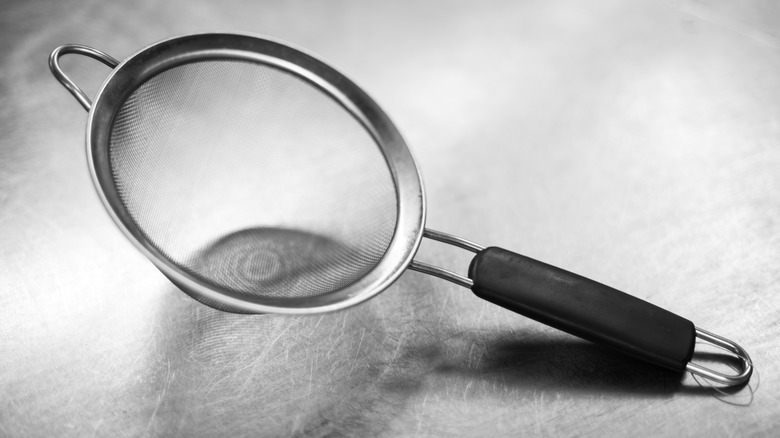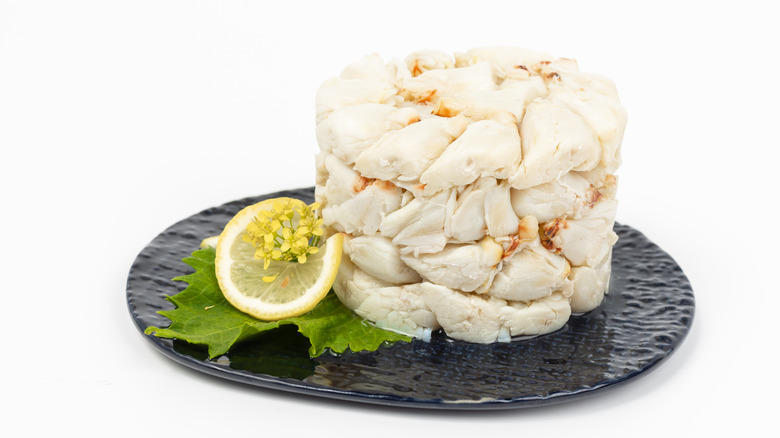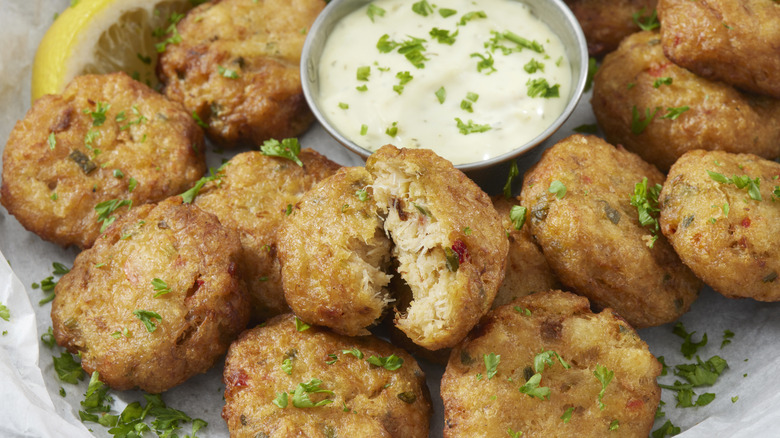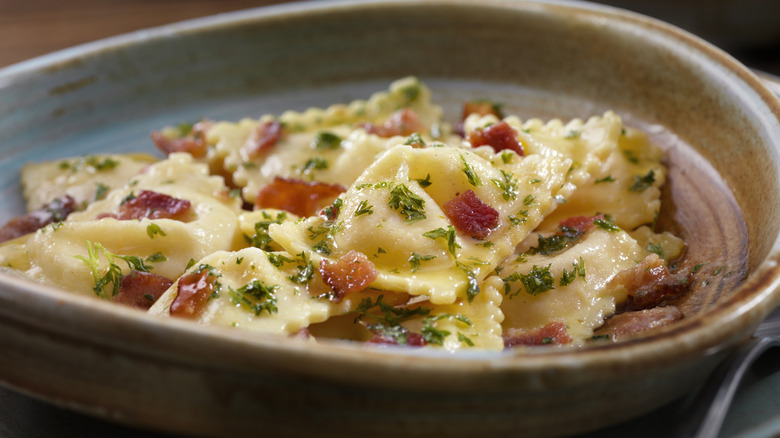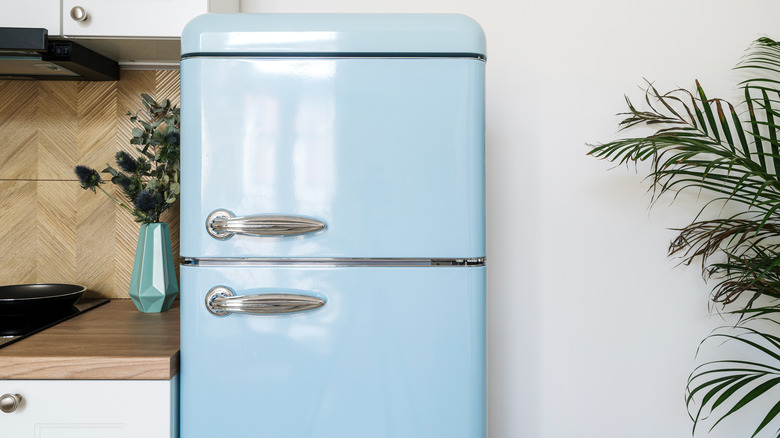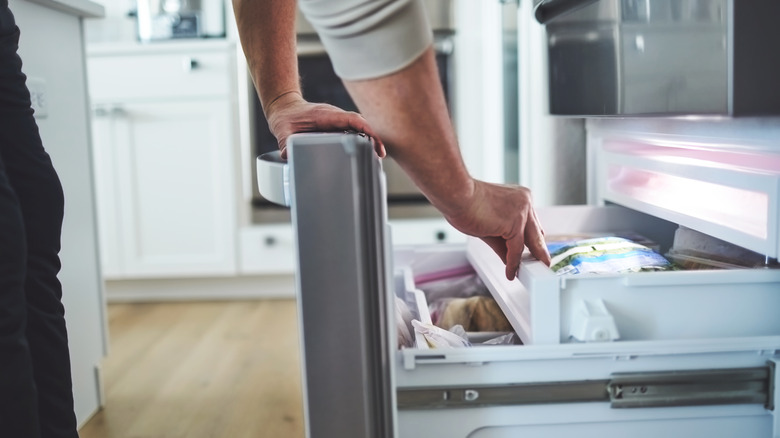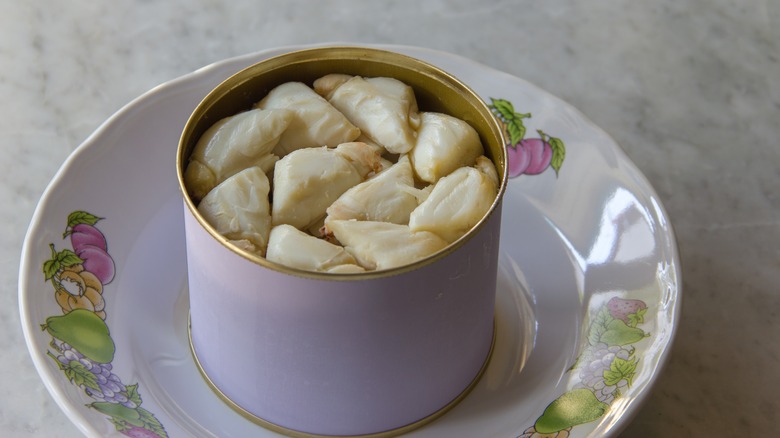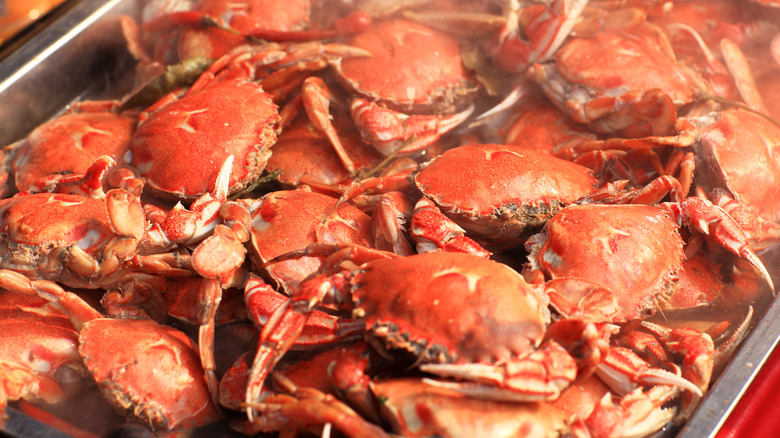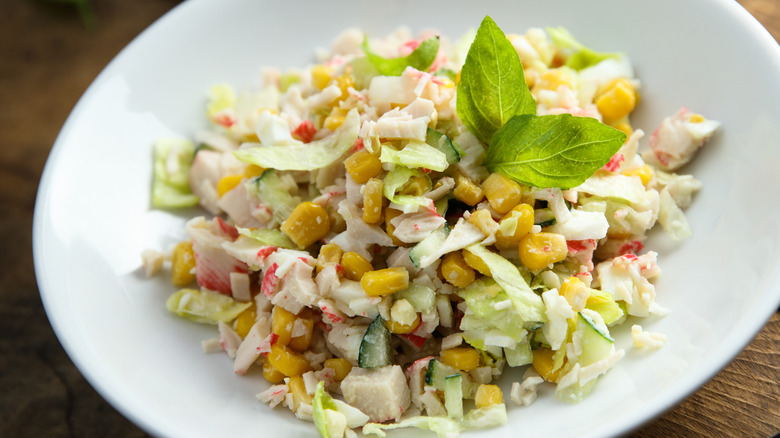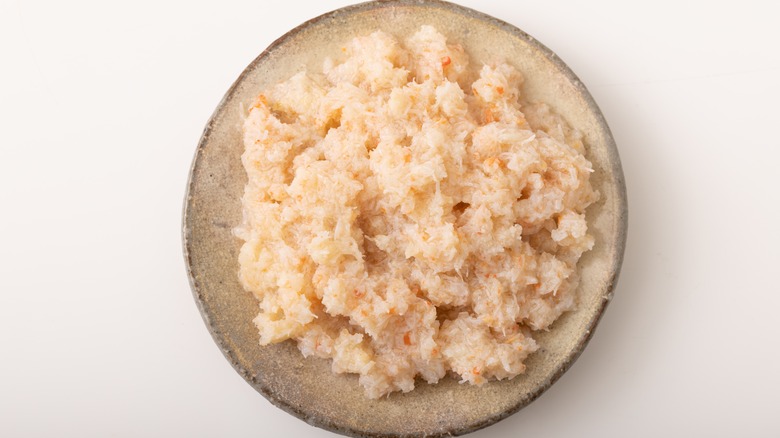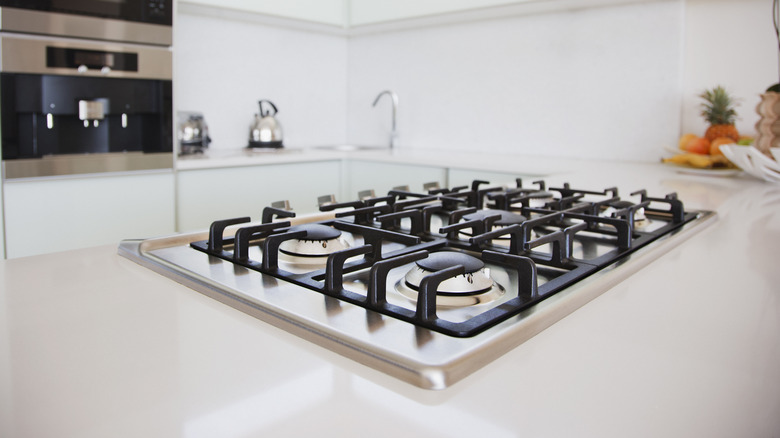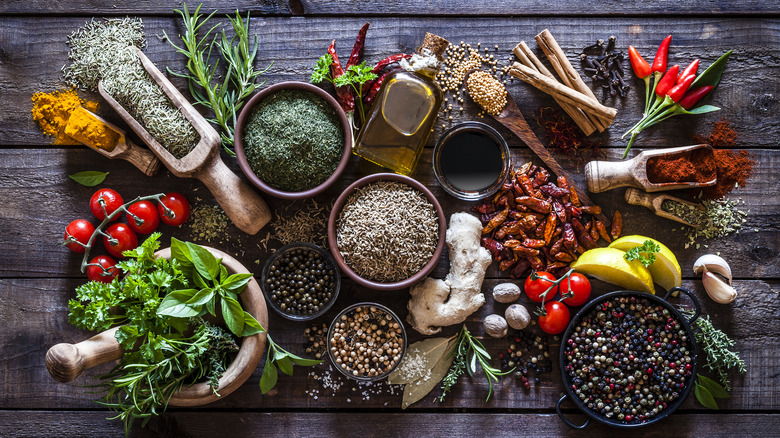14 Mistakes You're Making When Using Canned Crab Meat
Crab can be quite expensive because there's a lot involved when it comes to catching the crab, processing, and shipping it within a reasonable amount of time so it doesn't spoil. However, an affordable alternative is none other than canned crab meat. It's a convenient way to eat this crustacean and can be used in hot or cold dishes. Canned crab has a sweet, mild, buttery taste that sets it apart from other seafood. Its delicate, sweet flavor is superb for making anything from classic crab cakes to crab pasta.
However, if you're not seeing the same potential of the canned crab meat as we are, there might be a few mistakes you're making when using this ingredient, but don't fret because there are quick fixes. We will dive into the common missteps you'll often encounter and how you can correct them. If you're familiar with cooking with canned crabs, you might've encountered some of these already, while others you might not have thought of. Take these mistakes into consideration so you can unlock the full potential of this tasty canned good.
1. Skipping out on rinsing and drying the crab meat
While other tinned seafood, like canned tuna, doesn't necessarily need a rinse, it's best to wash crab meat. We're not talking about scrubbing it — just a brief soak and rinse under water will do. Draining and rinsing the crab is particularly helpful in removing some of the salt from the brine that the crab sits in, as well as any preservatives. You can pat the crab meat dry if you're following a recipe that doesn't require excess liquid. For example, something like crab cakes needs a drier consistency, so rinsing and patting the crab dry can benefit the dish.
This is a good practice when you want to monitor your sodium intake, or if you want better control over the recipe and crab meat's flavor and texture. The added salt can skew the flavor, particularly if you plan on adding salt or other ingredients.
2. Not freshening up canned crab meat with a milk bath
Freshen up that can of crab meat by soaking it in milk. While the seafood smell that happens during processing doesn't inherently mean that it's bad, the odor shouldn't be exceedingly fishy. If it does, you shouldn't eat it. When in doubt, try the milk bath method to see if it rids the smell. You can do this for 20 minutes or so, but for peak results, leave it in the fridge in a sealed container overnight. This can eliminate some of the unpleasant smell and taste that water alone can't replicate.
After the milk bath, rinse off the milk and pat dry since you don't want the milk to factor into the flavor either. The milk you use depends on preference and dietary needs, but a more full-fat version, like whole milk or heavy cream, works best as it's richer. This is a convenient tip because you're most likely to have some sort of milk in your refrigerator already. The hardest part is planning ahead to leave it in milk overnight.
3. Not keeping an eye out for crab shell pieces before cooking
You might be keen to open your can of crab meat and get cooking right away, but it's best to give it a once over for pieces of shells and bones. Open the can and then get a bowl or a plate. Look at each piece and then put it onto the clean dish so you can separate which ones you've gone through. Keep an eye out for any bits of shell or bone. For the most part, they get removed during processing, but there's always a chance that there's a fragment in there. It's kind of with pitted olives; at some point, you've come across a pit.
It's better to take the time to look through the crab so you don't end up chomping into a scrap of crunchy shell while you're trying to enjoy your meal. This tip is particularly applicable for softer foods where you'd notice a crisp component and where the crab is the main focal point of the dish, like crab risotto or crab mac and cheese. For something like crab tostadas loaded with toppings and crispy tostada, it might not be as noticeable. Either way, it doesn't hurt to take any shells or bones out.
4. Eating the canned crab meat by itself
Fresh crab meat is delicious on its own or dipped into melted garlic butter, but eating a canned version alone is one of the mistakes you're making when using the ingredient. As canned crab meat is cooked, you can technically consume it straight from the tin without other additions, like canned mussels or sardines, but it's most flavorful when paired with other ingredients. This is recommended because the canned variety isn't necessarily the same as fresh, especially based on the type of canned meat that you get. Even the higher quality super lump crab meat or jumbo lump crab meat that comes in larger pieces are best in dishes like Crab Imperial and aren't eaten alone.
Something like super lump has broken pieces that are smaller and more often used in something like crab cakes and dips. Canned crab is generally used in cooking from soups to casseroles, instead of eaten as it is, like you'd see with fresh crab legs. You won't often find recipes of people eating canned crab straight out of the tin, even amongst the higher-end types of crabs.
5. Only making crab cakes with the meat
There's no denying that crab cakes are delicious. They have that crispy fried surface and a soft, rich interior. But canned crab meat has so much more potential than just this dish. Whether you're looking to make dips, salads, soups, crab rangoon, or crab-stuffed mushrooms, there are many delicious recipes that you can create to let the crab shine. Make hot dishes or cold dishes, or play around with the shape of the crab meat — if you want shredded crab meat to mix into a spread or a dip or you prefer claw crab meat for a crab fettuccine.
There is an abundance of crab cake and crab ball recipes out there since it's one of the more prominent ways to use this canned meat, but we encourage you to experiment and find delight in other recipes to bring variation into your palette. From canned crab ravioli to chowder, you might find a few scrumptious ideas you might not have initially envisioned for this versatile seafood.
6. Only making difficult canned crab meat recipes
Perhaps you're trying to venture away from only making crab cakes, but now you're feeling overwhelmed by a recipe that has never-ending steps. Don't worry quite yet because there are loads of canned crab meat recipes that aren't too demanding to make. For example, make a very simple pasta with canned crab using your pasta of choice, whether that's angel hair, linguine, pappardelle, or something else. While you can certainly use pasta like penne or ziti, a longer pasta like fettuccine works best, so it doesn't overwhelm the crab. Use something like lump crab meat if you want larger crab chunks that you can really bite into, or try flaked crab meat that can easily blend in.
This ultimately boils down to personal preference and how big of crab pieces you want. Pair your pasta with garlic, butter, red pepper flakes, parsley, lemon juice, Parmesan, or other classic pasta flavoring. Endeavor making a quick crab salad using any type of canned crab and then pairing it with chopped celery, mayo, lemon juice, dill, red onion, or tomato. There are plenty of canned crab recipes that don't require a lot of labor to taste delicious.
7. Leaving leftovers for too long in the fridge
Once you open that can of crab meat, you only have so much time to use it up before it starts to get a little funky in your refrigerator. You don't want to leave it in your fridge for more than three to four days, and that's the absolute maximum. But using it within 48 hours is even better, though it has to be consistently refrigerated. Use it the next day if you're not fond of seafood leftovers to ensure its peak freshness. If you're not in the mood to make a whole rigamarole of a meal, quickly toss it in pasta or soup.
Rather than keeping it in the open tin, which can be one of the most common mistakes you make when using canned crab meat, transfer it to an airtight container or a jar with a lid so it's fully closed and sealed. This not only protects the shelf life of the crab meat but the rest of your refrigerator from starting to get that fishy crab stink. You probably don't want your produce to smell like two-day-old crab meat. Leaving it too long in the fridge is an easy mistake to make but just as easily rectifiable.
8. Not freezing canned crab meat
If you already know that you're not going to be able to finish your canned crab meat after opening it, freezing it in a freezer-safe container or baggie is a fantastic way to preserve it even longer. To save room in your freezer, freeze that leftover canned crab meat in the bag and try to remove as much air as possible before closing the seal. Put it in the freezer and lay it down flat. This way, it's almost like a vacuum seal and not a big, thick container that takes up a lot of room. Once frozen, you can move it vertically and strategically place it in the freezer wherever you want.
This can be a real space saver while also elongating the lifespan of your crab. Canned crab is certainly not as affordable as a can of beans, so freezing leftovers allows you to keep it fresh and get your money. No need to throw anything away. You can also store it in the fridge before freezing it the following day, in case you want to use it earlier than expected. But don't wait too long to freeze it. When you're ready to use it, thaw it in the fridge overnight or run it under cold water for about eight minutes.
9. Thinking there's only one type of canned crab meat
Not all canned crab is equal. There are different types of crab meats to consider when making a meal, such as white crab meat, lump crab, claw, jumbo, colossal crab, and more. The types of canned crab meat ultimately depend on the part of the body that is used. Colossal and jumbo lumps come from two unbroken muscles, which make for large pieces of meat, whereas super lumps use broken and smaller pieces and flakes.
As if the options weren't confusing enough, certain types of crab meat go better with specific dishes. While you have a lot of flexibility in soups or pasta because the texture doesn't ruin the overall consistency of the meal, you do want to consider particular meats for things like crab cakes. Shredded crab meat can be utilized in many dishes, from casseroles to soups to salads, because it's made with smaller pieces. This is excellent when you don't want to do any extra chopping. Super lump crab meat has broken bits of jumbo lump and large flakes that allow for bigger bites of crab when you want a more noticeable nibble for a hearty salad or added into a sushi bake.
10. Not factoring in sustainability or reputable brands
Affordability and accessibility are huge factors when it comes to canned goods. As nice as it is to have fresh crab, you might not have a fish market near you or it's not feasible for the crab to get there within its time of pinnacle freshness. This is why canned crab meat is a more handy way for people to eat the crustacean. However, there are some considerations to keep in mind to ensure sustainability for the environment and the crabs themselves. This means the crabs come from a healthy and thriving population with little or no impact on surrounding marine life.
Essentially, avoid purchasing crab from overfishing or places where the fishing is unregulated or unreported. This might be overwhelming, but for ease, you can consult the Monterey Bay Aquarium Seafood Watch quick guide to learn where to buy and where to avoid purchasing canned crab. The most sustainable options boil down to how they're caught and if they're farmed responsibly.
11. Assuming that canned crab is the inferior way to eat crab
Just because it's canned doesn't mean it's a poor-quality crab. Not everyone lives by bodies of water to have fresh crab, and even if you do, it can be extremely expensive. Canned crab allows you to have access at a more reasonable price range, and it's still crab meat. Canned crab isn't any worse quality than fresh — it has just been canned, but you can seek qualities for the best canned crab, such as the differences in the types of crab meat itself. Even so, people can prefer one over the other. Some might lean toward jumbo crab meat, colossal, and lump crab meat simply because they have larger pieces while others swear by the intensity of claw crab meat.
There are various qualities of the actual crab itself. King crab is one of the more expensive crabs, but you can also find it canned. If you're willing to pay the price, you can find a range of canned crab items, which can be all the more alluring. If you're unable to get fresh crab within its pinnacle freshness window, don't be afraid to experiment with canned crab meat, especially if you're buying from sustainable and reputable brands where you know that the quality and flavor are there.
12. Writing off canned crab meat as non-nutritious
Canning foods has been a way to preserve food for a long time, whether that's meat, vegetables, or fruits. It has been an economical way to store food, and just because it's canned doesn't mean the nutrition evaporates into thin air. The canned versions still contain nutrients that are in the crab even though there are some preservatives in most cans. For example, canned blue crab has protein, calcium, magnesium, phosphorus, potassium, zinc, copper, vitamin C, niacin, and many other minerals and nutrients to make it a balanced food.
Canned crab tends to get seasoned and paired with other items, such as a side of roasted asparagus or broccoli, or topped on whole-grain brown rice, but it can also be incorporated into more involved dishes, such as crab-stuffed salmon. There's no lack of nourishing combinations and ways to eat canned crab, and the nutrition gets compounded when eating it with other sustaining components like vegetables or whole grains such as quinoa or barley.
13. Always heating or cooking the canned crab meat
Since most canned crabs are pasteurized, you don't necessarily have to cook them if you don't want to or if a recipe calls for eating them cold. If you're wondering whether canned crab meat is cooked or raw, it already comes cooked since it's the most effective way to remove the crab from the shell during processing. You don't have to cook the crab when making cold dishes like cold crab dip with cream cheese, mayo, garlic, hot sauce, and other ingredients. This type of dish is fantastic to make and serve along with crackers at a party.
There's no cooking or heating involved, which makes this an enticing option when you're not in the mood to turn on the stove and spend the afternoon cooking. A dip can be prepared and then stored in the fridge until you're ready to eat it. Make a crab ceviche with canned crab meat, red onion, jalapeño, tomato, lime, and any other ceviche fixings. This is a refreshing dish to eat on a summer afternoon on a tostada or a piece of toast. You could also pair it with shrimp for a seafood delight. Eating it cold also allows you to enjoy the nuanced flavor of the crab, too.
14. Not seasoning the canned crab meat properly
Like most foods, avoid under-seasoning or over-seasoning crab meat so it doesn't overthrow its delicate flavor. Seasoning is a fabulous way to bring out the natural sweetness and texture of canned crab meat, but overdoing or underdoing it is one of the common mistakes made when using canned crab meat. Use a couple of common seasonings to provide flavor enhancements. Crab often gets paired with lemon juice, garlic, and butter, but you'll also see it with fresh herbs like dill or parsley. Salt and pepper are a familiar addition to anything from crab cakes to crab pasta.
Canned crab is frequently packed with salt, so adding a pile of salt doesn't make it taste any better. Instead, you can season it with complementary flavors like Worcestershire sauce or mustard. One seasoning isn't better than the other, but over-seasoning can overpower a dish and under-seasoning can make it bland. Since crab meat is cooked, you can feel comfortable tasting it as you go while you experiment with flavor. When in doubt, follow the recipe which has already been tested.

